Leadership and Management Style of Elizabeth Holmes: A Case Study
VerifiedAdded on 2023/06/04
|11
|3621
|106
AI Summary
This report covers the leadership and management style of Elizabeth Holmes, the CEO of Theranos, and provides a brief analysis of the risk and performance of the company. It discusses her strengths and weaknesses as a leader, the ethical lines she crossed, and their effects on the community. The report also covers the organisational culture elements that influenced her behaviour, the outside influences on her decisions, and the outcomes and lessons learned from her case. The report is relevant to the subject MG629 Developing Leadership & Management Skills.
Contribute Materials
Your contribution can guide someone’s learning journey. Share your
documents today.
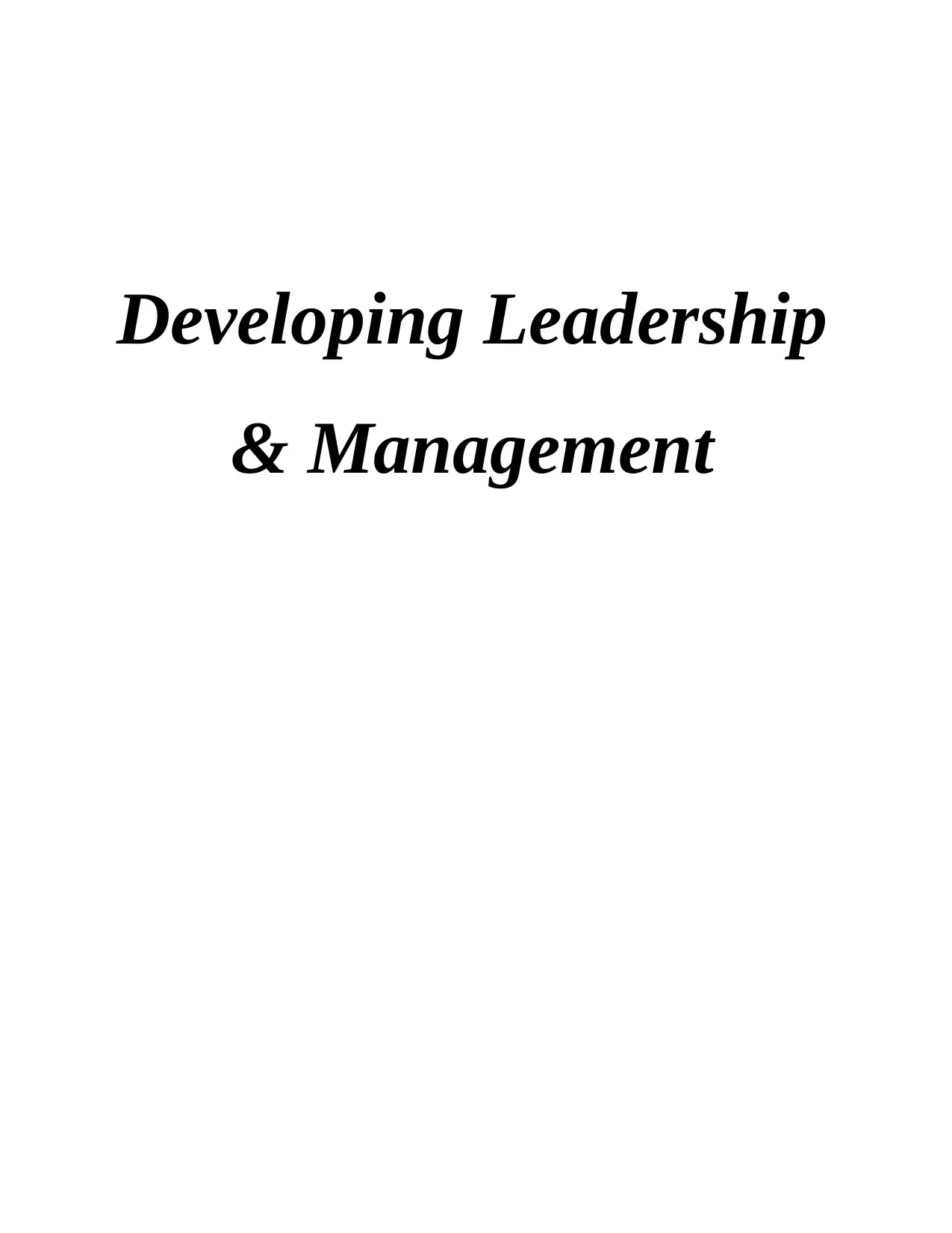
Developing Leadership
& Management
& Management
Secure Best Marks with AI Grader
Need help grading? Try our AI Grader for instant feedback on your assignments.
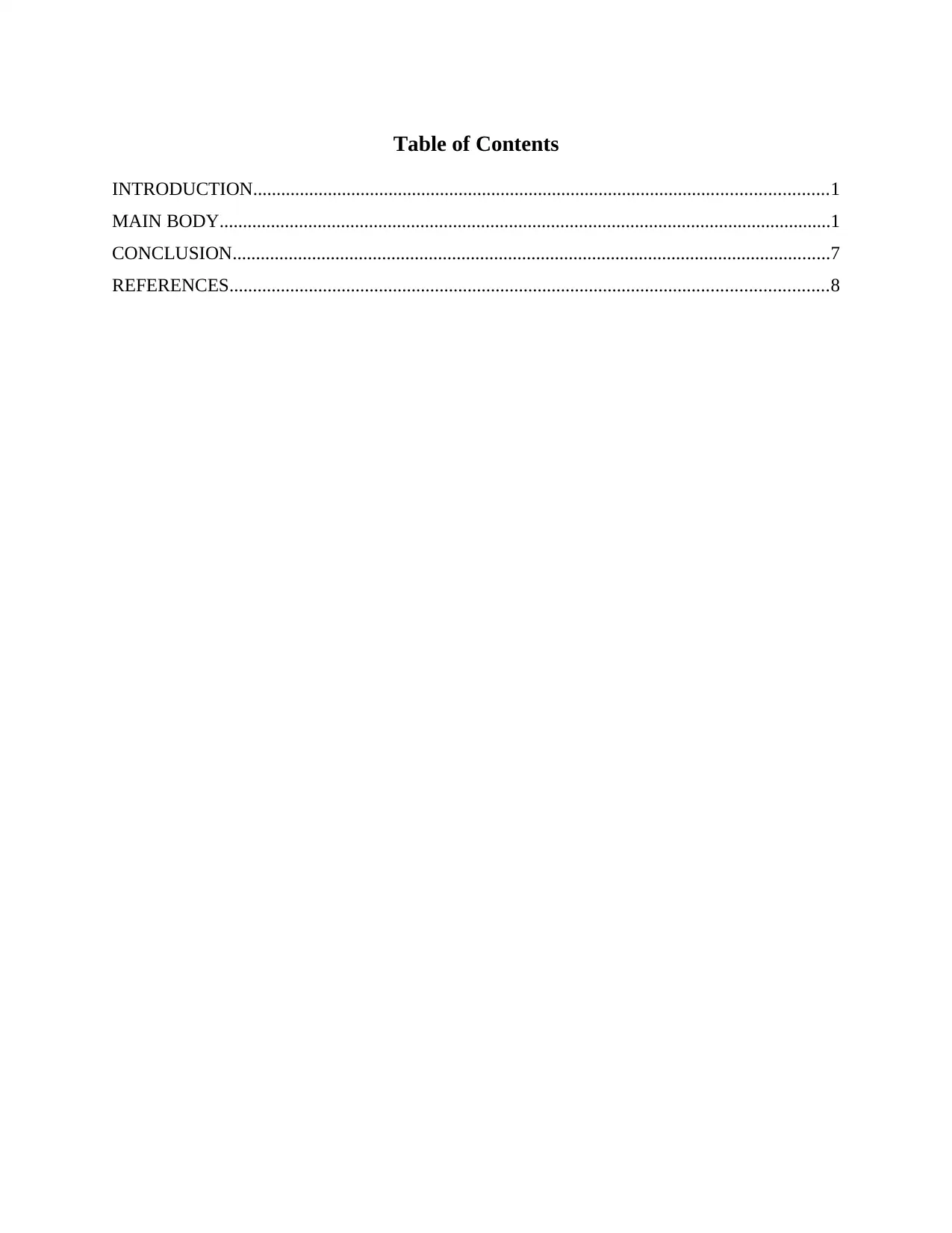
Table of Contents
INTRODUCTION...........................................................................................................................1
MAIN BODY...................................................................................................................................1
CONCLUSION................................................................................................................................7
REFERENCES................................................................................................................................8
INTRODUCTION...........................................................................................................................1
MAIN BODY...................................................................................................................................1
CONCLUSION................................................................................................................................7
REFERENCES................................................................................................................................8
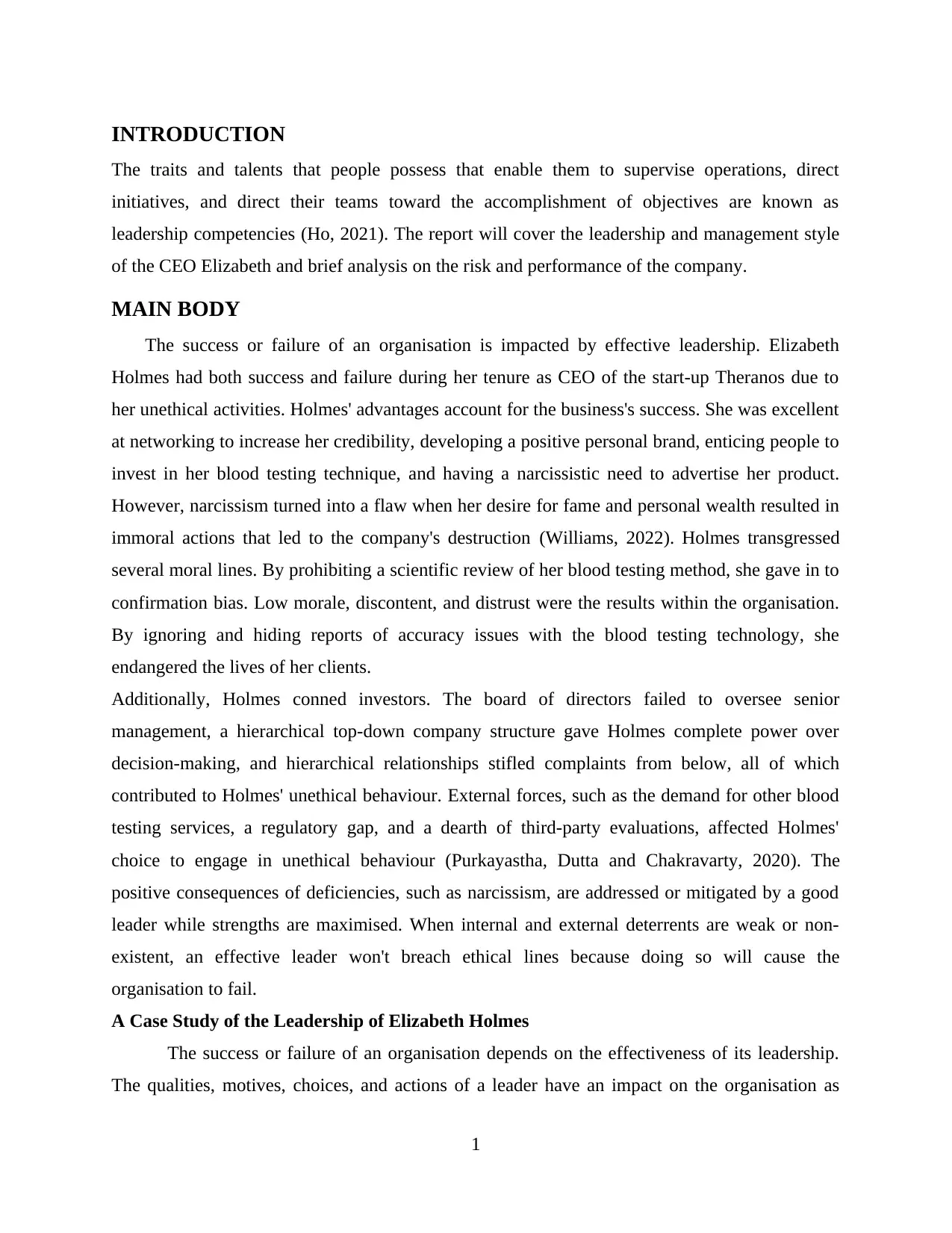
INTRODUCTION
The traits and talents that people possess that enable them to supervise operations, direct
initiatives, and direct their teams toward the accomplishment of objectives are known as
leadership competencies (Ho, 2021). The report will cover the leadership and management style
of the CEO Elizabeth and brief analysis on the risk and performance of the company.
MAIN BODY
The success or failure of an organisation is impacted by effective leadership. Elizabeth
Holmes had both success and failure during her tenure as CEO of the start-up Theranos due to
her unethical activities. Holmes' advantages account for the business's success. She was excellent
at networking to increase her credibility, developing a positive personal brand, enticing people to
invest in her blood testing technique, and having a narcissistic need to advertise her product.
However, narcissism turned into a flaw when her desire for fame and personal wealth resulted in
immoral actions that led to the company's destruction (Williams, 2022). Holmes transgressed
several moral lines. By prohibiting a scientific review of her blood testing method, she gave in to
confirmation bias. Low morale, discontent, and distrust were the results within the organisation.
By ignoring and hiding reports of accuracy issues with the blood testing technology, she
endangered the lives of her clients.
Additionally, Holmes conned investors. The board of directors failed to oversee senior
management, a hierarchical top-down company structure gave Holmes complete power over
decision-making, and hierarchical relationships stifled complaints from below, all of which
contributed to Holmes' unethical behaviour. External forces, such as the demand for other blood
testing services, a regulatory gap, and a dearth of third-party evaluations, affected Holmes'
choice to engage in unethical behaviour (Purkayastha, Dutta and Chakravarty, 2020). The
positive consequences of deficiencies, such as narcissism, are addressed or mitigated by a good
leader while strengths are maximised. When internal and external deterrents are weak or non-
existent, an effective leader won't breach ethical lines because doing so will cause the
organisation to fail.
A Case Study of the Leadership of Elizabeth Holmes
The success or failure of an organisation depends on the effectiveness of its leadership.
The qualities, motives, choices, and actions of a leader have an impact on the organisation as
1
The traits and talents that people possess that enable them to supervise operations, direct
initiatives, and direct their teams toward the accomplishment of objectives are known as
leadership competencies (Ho, 2021). The report will cover the leadership and management style
of the CEO Elizabeth and brief analysis on the risk and performance of the company.
MAIN BODY
The success or failure of an organisation is impacted by effective leadership. Elizabeth
Holmes had both success and failure during her tenure as CEO of the start-up Theranos due to
her unethical activities. Holmes' advantages account for the business's success. She was excellent
at networking to increase her credibility, developing a positive personal brand, enticing people to
invest in her blood testing technique, and having a narcissistic need to advertise her product.
However, narcissism turned into a flaw when her desire for fame and personal wealth resulted in
immoral actions that led to the company's destruction (Williams, 2022). Holmes transgressed
several moral lines. By prohibiting a scientific review of her blood testing method, she gave in to
confirmation bias. Low morale, discontent, and distrust were the results within the organisation.
By ignoring and hiding reports of accuracy issues with the blood testing technology, she
endangered the lives of her clients.
Additionally, Holmes conned investors. The board of directors failed to oversee senior
management, a hierarchical top-down company structure gave Holmes complete power over
decision-making, and hierarchical relationships stifled complaints from below, all of which
contributed to Holmes' unethical behaviour. External forces, such as the demand for other blood
testing services, a regulatory gap, and a dearth of third-party evaluations, affected Holmes'
choice to engage in unethical behaviour (Purkayastha, Dutta and Chakravarty, 2020). The
positive consequences of deficiencies, such as narcissism, are addressed or mitigated by a good
leader while strengths are maximised. When internal and external deterrents are weak or non-
existent, an effective leader won't breach ethical lines because doing so will cause the
organisation to fail.
A Case Study of the Leadership of Elizabeth Holmes
The success or failure of an organisation depends on the effectiveness of its leadership.
The qualities, motives, choices, and actions of a leader have an impact on the organisation as
1
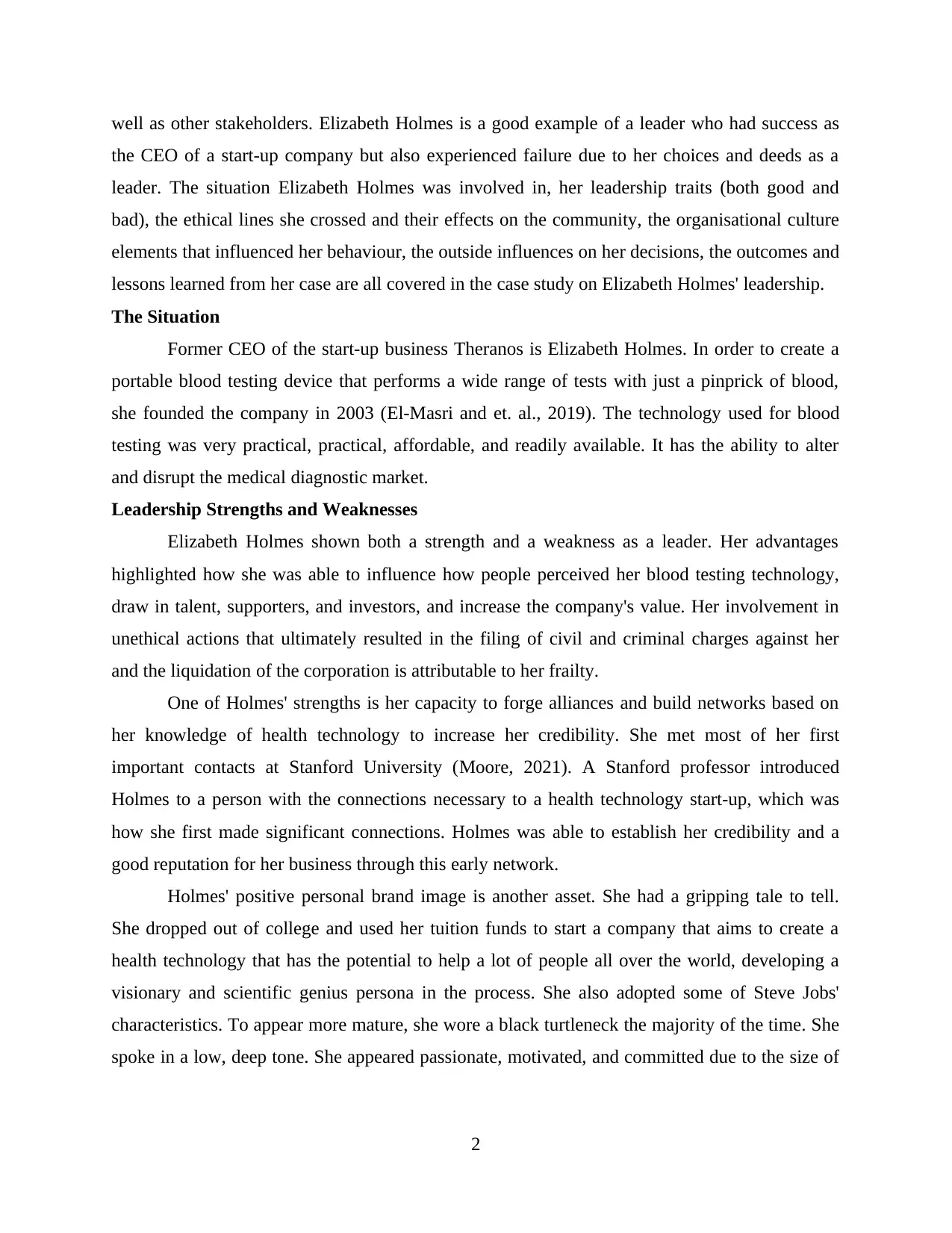
well as other stakeholders. Elizabeth Holmes is a good example of a leader who had success as
the CEO of a start-up company but also experienced failure due to her choices and deeds as a
leader. The situation Elizabeth Holmes was involved in, her leadership traits (both good and
bad), the ethical lines she crossed and their effects on the community, the organisational culture
elements that influenced her behaviour, the outside influences on her decisions, the outcomes and
lessons learned from her case are all covered in the case study on Elizabeth Holmes' leadership.
The Situation
Former CEO of the start-up business Theranos is Elizabeth Holmes. In order to create a
portable blood testing device that performs a wide range of tests with just a pinprick of blood,
she founded the company in 2003 (El-Masri and et. al., 2019). The technology used for blood
testing was very practical, practical, affordable, and readily available. It has the ability to alter
and disrupt the medical diagnostic market.
Leadership Strengths and Weaknesses
Elizabeth Holmes shown both a strength and a weakness as a leader. Her advantages
highlighted how she was able to influence how people perceived her blood testing technology,
draw in talent, supporters, and investors, and increase the company's value. Her involvement in
unethical actions that ultimately resulted in the filing of civil and criminal charges against her
and the liquidation of the corporation is attributable to her frailty.
One of Holmes' strengths is her capacity to forge alliances and build networks based on
her knowledge of health technology to increase her credibility. She met most of her first
important contacts at Stanford University (Moore, 2021). A Stanford professor introduced
Holmes to a person with the connections necessary to a health technology start-up, which was
how she first made significant connections. Holmes was able to establish her credibility and a
good reputation for her business through this early network.
Holmes' positive personal brand image is another asset. She had a gripping tale to tell.
She dropped out of college and used her tuition funds to start a company that aims to create a
health technology that has the potential to help a lot of people all over the world, developing a
visionary and scientific genius persona in the process. She also adopted some of Steve Jobs'
characteristics. To appear more mature, she wore a black turtleneck the majority of the time. She
spoke in a low, deep tone. She appeared passionate, motivated, and committed due to the size of
2
the CEO of a start-up company but also experienced failure due to her choices and deeds as a
leader. The situation Elizabeth Holmes was involved in, her leadership traits (both good and
bad), the ethical lines she crossed and their effects on the community, the organisational culture
elements that influenced her behaviour, the outside influences on her decisions, the outcomes and
lessons learned from her case are all covered in the case study on Elizabeth Holmes' leadership.
The Situation
Former CEO of the start-up business Theranos is Elizabeth Holmes. In order to create a
portable blood testing device that performs a wide range of tests with just a pinprick of blood,
she founded the company in 2003 (El-Masri and et. al., 2019). The technology used for blood
testing was very practical, practical, affordable, and readily available. It has the ability to alter
and disrupt the medical diagnostic market.
Leadership Strengths and Weaknesses
Elizabeth Holmes shown both a strength and a weakness as a leader. Her advantages
highlighted how she was able to influence how people perceived her blood testing technology,
draw in talent, supporters, and investors, and increase the company's value. Her involvement in
unethical actions that ultimately resulted in the filing of civil and criminal charges against her
and the liquidation of the corporation is attributable to her frailty.
One of Holmes' strengths is her capacity to forge alliances and build networks based on
her knowledge of health technology to increase her credibility. She met most of her first
important contacts at Stanford University (Moore, 2021). A Stanford professor introduced
Holmes to a person with the connections necessary to a health technology start-up, which was
how she first made significant connections. Holmes was able to establish her credibility and a
good reputation for her business through this early network.
Holmes' positive personal brand image is another asset. She had a gripping tale to tell.
She dropped out of college and used her tuition funds to start a company that aims to create a
health technology that has the potential to help a lot of people all over the world, developing a
visionary and scientific genius persona in the process. She also adopted some of Steve Jobs'
characteristics. To appear more mature, she wore a black turtleneck the majority of the time. She
spoke in a low, deep tone. She appeared passionate, motivated, and committed due to the size of
2
Secure Best Marks with AI Grader
Need help grading? Try our AI Grader for instant feedback on your assignments.
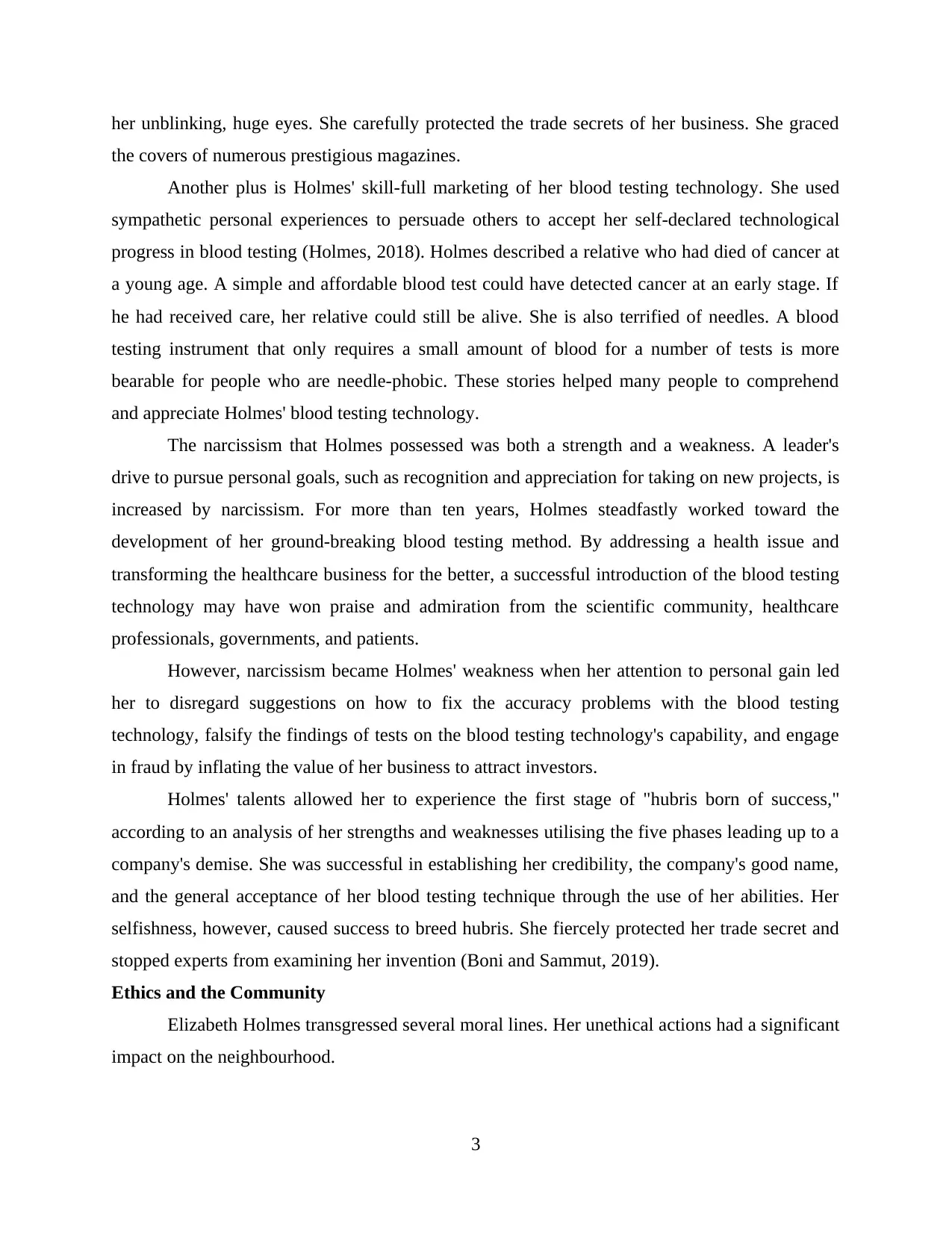
her unblinking, huge eyes. She carefully protected the trade secrets of her business. She graced
the covers of numerous prestigious magazines.
Another plus is Holmes' skill-full marketing of her blood testing technology. She used
sympathetic personal experiences to persuade others to accept her self-declared technological
progress in blood testing (Holmes, 2018). Holmes described a relative who had died of cancer at
a young age. A simple and affordable blood test could have detected cancer at an early stage. If
he had received care, her relative could still be alive. She is also terrified of needles. A blood
testing instrument that only requires a small amount of blood for a number of tests is more
bearable for people who are needle-phobic. These stories helped many people to comprehend
and appreciate Holmes' blood testing technology.
The narcissism that Holmes possessed was both a strength and a weakness. A leader's
drive to pursue personal goals, such as recognition and appreciation for taking on new projects, is
increased by narcissism. For more than ten years, Holmes steadfastly worked toward the
development of her ground-breaking blood testing method. By addressing a health issue and
transforming the healthcare business for the better, a successful introduction of the blood testing
technology may have won praise and admiration from the scientific community, healthcare
professionals, governments, and patients.
However, narcissism became Holmes' weakness when her attention to personal gain led
her to disregard suggestions on how to fix the accuracy problems with the blood testing
technology, falsify the findings of tests on the blood testing technology's capability, and engage
in fraud by inflating the value of her business to attract investors.
Holmes' talents allowed her to experience the first stage of "hubris born of success,"
according to an analysis of her strengths and weaknesses utilising the five phases leading up to a
company's demise. She was successful in establishing her credibility, the company's good name,
and the general acceptance of her blood testing technique through the use of her abilities. Her
selfishness, however, caused success to breed hubris. She fiercely protected her trade secret and
stopped experts from examining her invention (Boni and Sammut, 2019).
Ethics and the Community
Elizabeth Holmes transgressed several moral lines. Her unethical actions had a significant
impact on the neighbourhood.
3
the covers of numerous prestigious magazines.
Another plus is Holmes' skill-full marketing of her blood testing technology. She used
sympathetic personal experiences to persuade others to accept her self-declared technological
progress in blood testing (Holmes, 2018). Holmes described a relative who had died of cancer at
a young age. A simple and affordable blood test could have detected cancer at an early stage. If
he had received care, her relative could still be alive. She is also terrified of needles. A blood
testing instrument that only requires a small amount of blood for a number of tests is more
bearable for people who are needle-phobic. These stories helped many people to comprehend
and appreciate Holmes' blood testing technology.
The narcissism that Holmes possessed was both a strength and a weakness. A leader's
drive to pursue personal goals, such as recognition and appreciation for taking on new projects, is
increased by narcissism. For more than ten years, Holmes steadfastly worked toward the
development of her ground-breaking blood testing method. By addressing a health issue and
transforming the healthcare business for the better, a successful introduction of the blood testing
technology may have won praise and admiration from the scientific community, healthcare
professionals, governments, and patients.
However, narcissism became Holmes' weakness when her attention to personal gain led
her to disregard suggestions on how to fix the accuracy problems with the blood testing
technology, falsify the findings of tests on the blood testing technology's capability, and engage
in fraud by inflating the value of her business to attract investors.
Holmes' talents allowed her to experience the first stage of "hubris born of success,"
according to an analysis of her strengths and weaknesses utilising the five phases leading up to a
company's demise. She was successful in establishing her credibility, the company's good name,
and the general acceptance of her blood testing technique through the use of her abilities. Her
selfishness, however, caused success to breed hubris. She fiercely protected her trade secret and
stopped experts from examining her invention (Boni and Sammut, 2019).
Ethics and the Community
Elizabeth Holmes transgressed several moral lines. Her unethical actions had a significant
impact on the neighbourhood.
3
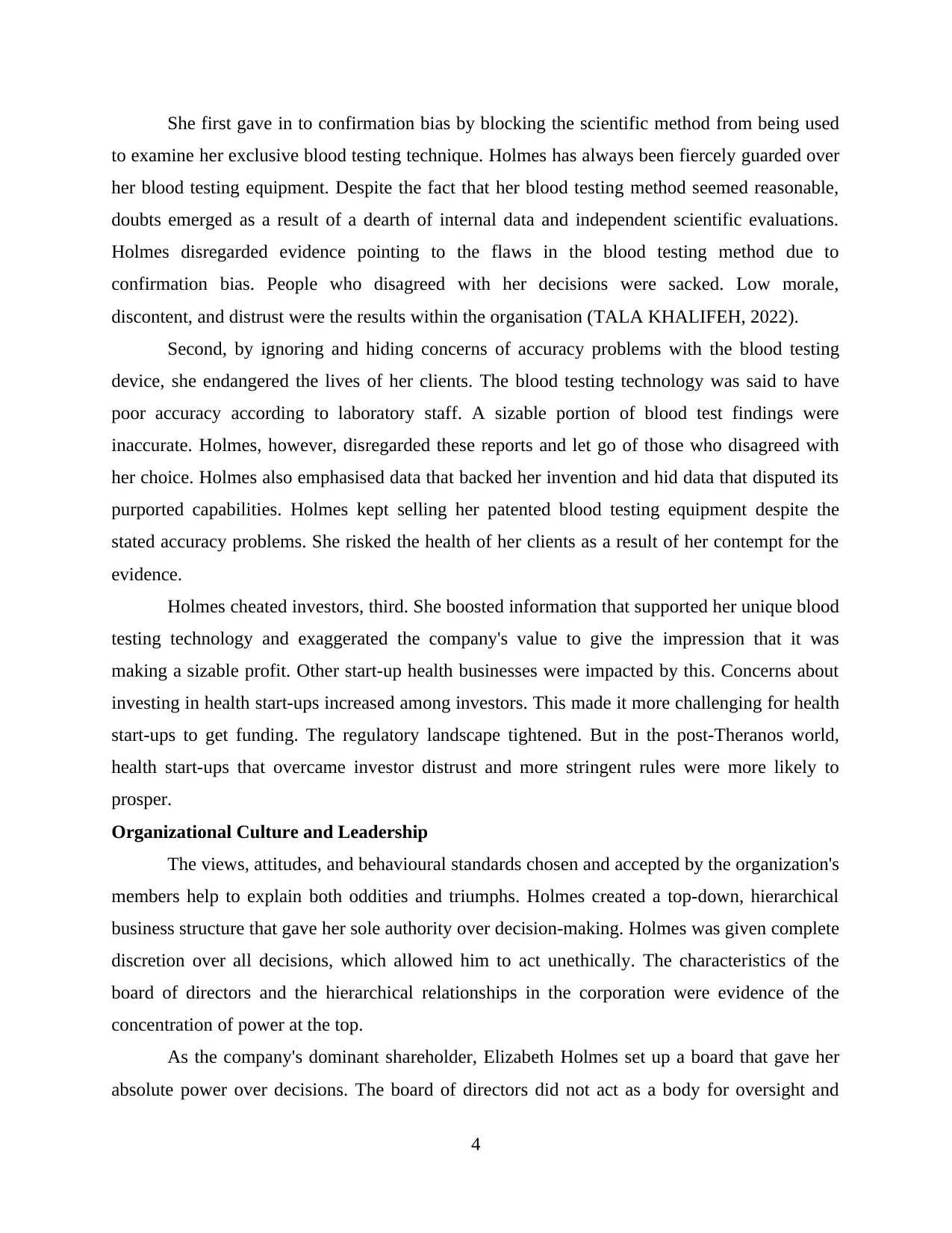
She first gave in to confirmation bias by blocking the scientific method from being used
to examine her exclusive blood testing technique. Holmes has always been fiercely guarded over
her blood testing equipment. Despite the fact that her blood testing method seemed reasonable,
doubts emerged as a result of a dearth of internal data and independent scientific evaluations.
Holmes disregarded evidence pointing to the flaws in the blood testing method due to
confirmation bias. People who disagreed with her decisions were sacked. Low morale,
discontent, and distrust were the results within the organisation (TALA KHALIFEH, 2022).
Second, by ignoring and hiding concerns of accuracy problems with the blood testing
device, she endangered the lives of her clients. The blood testing technology was said to have
poor accuracy according to laboratory staff. A sizable portion of blood test findings were
inaccurate. Holmes, however, disregarded these reports and let go of those who disagreed with
her choice. Holmes also emphasised data that backed her invention and hid data that disputed its
purported capabilities. Holmes kept selling her patented blood testing equipment despite the
stated accuracy problems. She risked the health of her clients as a result of her contempt for the
evidence.
Holmes cheated investors, third. She boosted information that supported her unique blood
testing technology and exaggerated the company's value to give the impression that it was
making a sizable profit. Other start-up health businesses were impacted by this. Concerns about
investing in health start-ups increased among investors. This made it more challenging for health
start-ups to get funding. The regulatory landscape tightened. But in the post-Theranos world,
health start-ups that overcame investor distrust and more stringent rules were more likely to
prosper.
Organizational Culture and Leadership
The views, attitudes, and behavioural standards chosen and accepted by the organization's
members help to explain both oddities and triumphs. Holmes created a top-down, hierarchical
business structure that gave her sole authority over decision-making. Holmes was given complete
discretion over all decisions, which allowed him to act unethically. The characteristics of the
board of directors and the hierarchical relationships in the corporation were evidence of the
concentration of power at the top.
As the company's dominant shareholder, Elizabeth Holmes set up a board that gave her
absolute power over decisions. The board of directors did not act as a body for oversight and
4
to examine her exclusive blood testing technique. Holmes has always been fiercely guarded over
her blood testing equipment. Despite the fact that her blood testing method seemed reasonable,
doubts emerged as a result of a dearth of internal data and independent scientific evaluations.
Holmes disregarded evidence pointing to the flaws in the blood testing method due to
confirmation bias. People who disagreed with her decisions were sacked. Low morale,
discontent, and distrust were the results within the organisation (TALA KHALIFEH, 2022).
Second, by ignoring and hiding concerns of accuracy problems with the blood testing
device, she endangered the lives of her clients. The blood testing technology was said to have
poor accuracy according to laboratory staff. A sizable portion of blood test findings were
inaccurate. Holmes, however, disregarded these reports and let go of those who disagreed with
her choice. Holmes also emphasised data that backed her invention and hid data that disputed its
purported capabilities. Holmes kept selling her patented blood testing equipment despite the
stated accuracy problems. She risked the health of her clients as a result of her contempt for the
evidence.
Holmes cheated investors, third. She boosted information that supported her unique blood
testing technology and exaggerated the company's value to give the impression that it was
making a sizable profit. Other start-up health businesses were impacted by this. Concerns about
investing in health start-ups increased among investors. This made it more challenging for health
start-ups to get funding. The regulatory landscape tightened. But in the post-Theranos world,
health start-ups that overcame investor distrust and more stringent rules were more likely to
prosper.
Organizational Culture and Leadership
The views, attitudes, and behavioural standards chosen and accepted by the organization's
members help to explain both oddities and triumphs. Holmes created a top-down, hierarchical
business structure that gave her sole authority over decision-making. Holmes was given complete
discretion over all decisions, which allowed him to act unethically. The characteristics of the
board of directors and the hierarchical relationships in the corporation were evidence of the
concentration of power at the top.
As the company's dominant shareholder, Elizabeth Holmes set up a board that gave her
absolute power over decisions. The board of directors did not act as a body for oversight and
4
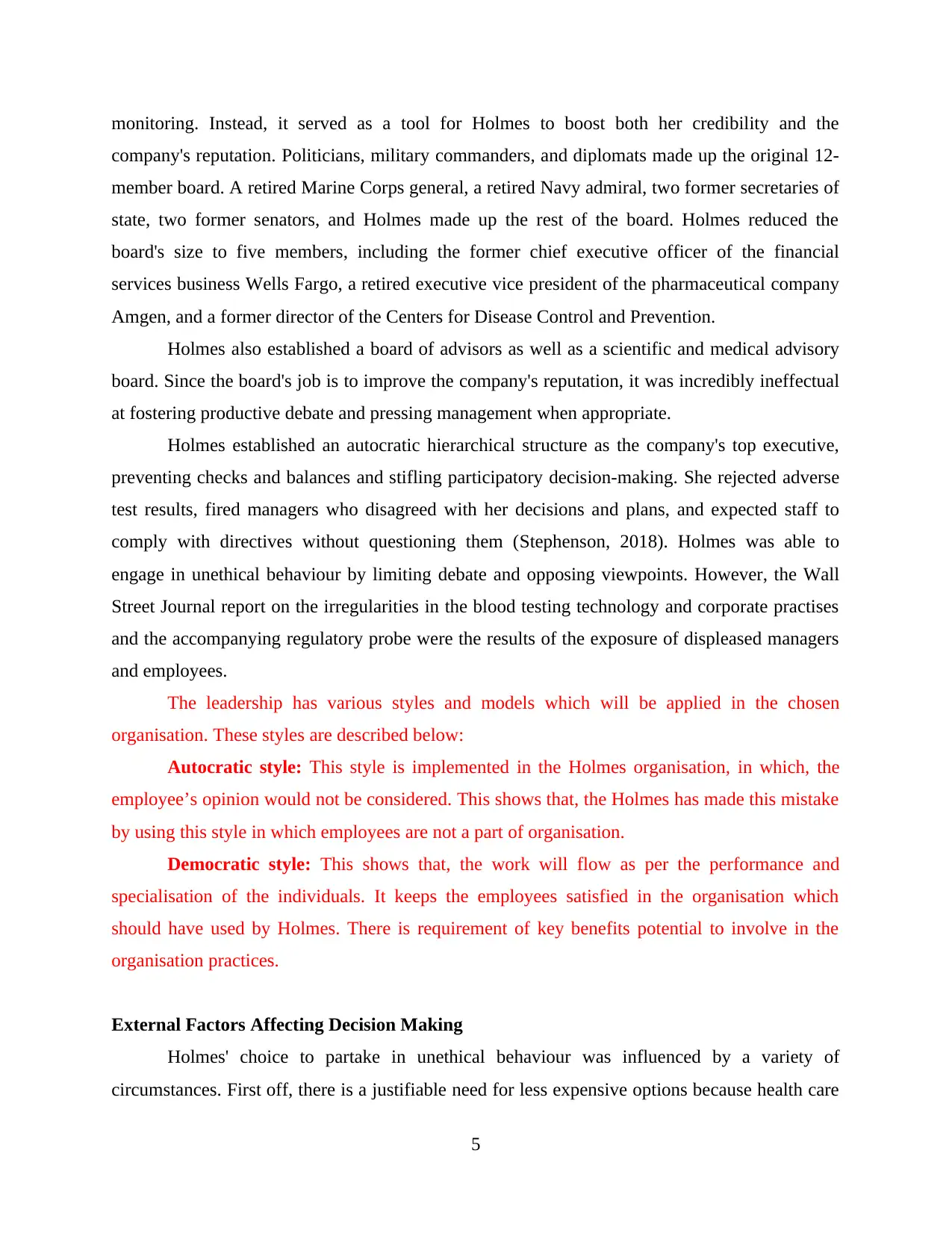
monitoring. Instead, it served as a tool for Holmes to boost both her credibility and the
company's reputation. Politicians, military commanders, and diplomats made up the original 12-
member board. A retired Marine Corps general, a retired Navy admiral, two former secretaries of
state, two former senators, and Holmes made up the rest of the board. Holmes reduced the
board's size to five members, including the former chief executive officer of the financial
services business Wells Fargo, a retired executive vice president of the pharmaceutical company
Amgen, and a former director of the Centers for Disease Control and Prevention.
Holmes also established a board of advisors as well as a scientific and medical advisory
board. Since the board's job is to improve the company's reputation, it was incredibly ineffectual
at fostering productive debate and pressing management when appropriate.
Holmes established an autocratic hierarchical structure as the company's top executive,
preventing checks and balances and stifling participatory decision-making. She rejected adverse
test results, fired managers who disagreed with her decisions and plans, and expected staff to
comply with directives without questioning them (Stephenson, 2018). Holmes was able to
engage in unethical behaviour by limiting debate and opposing viewpoints. However, the Wall
Street Journal report on the irregularities in the blood testing technology and corporate practises
and the accompanying regulatory probe were the results of the exposure of displeased managers
and employees.
The leadership has various styles and models which will be applied in the chosen
organisation. These styles are described below:
Autocratic style: This style is implemented in the Holmes organisation, in which, the
employee’s opinion would not be considered. This shows that, the Holmes has made this mistake
by using this style in which employees are not a part of organisation.
Democratic style: This shows that, the work will flow as per the performance and
specialisation of the individuals. It keeps the employees satisfied in the organisation which
should have used by Holmes. There is requirement of key benefits potential to involve in the
organisation practices.
External Factors Affecting Decision Making
Holmes' choice to partake in unethical behaviour was influenced by a variety of
circumstances. First off, there is a justifiable need for less expensive options because health care
5
company's reputation. Politicians, military commanders, and diplomats made up the original 12-
member board. A retired Marine Corps general, a retired Navy admiral, two former secretaries of
state, two former senators, and Holmes made up the rest of the board. Holmes reduced the
board's size to five members, including the former chief executive officer of the financial
services business Wells Fargo, a retired executive vice president of the pharmaceutical company
Amgen, and a former director of the Centers for Disease Control and Prevention.
Holmes also established a board of advisors as well as a scientific and medical advisory
board. Since the board's job is to improve the company's reputation, it was incredibly ineffectual
at fostering productive debate and pressing management when appropriate.
Holmes established an autocratic hierarchical structure as the company's top executive,
preventing checks and balances and stifling participatory decision-making. She rejected adverse
test results, fired managers who disagreed with her decisions and plans, and expected staff to
comply with directives without questioning them (Stephenson, 2018). Holmes was able to
engage in unethical behaviour by limiting debate and opposing viewpoints. However, the Wall
Street Journal report on the irregularities in the blood testing technology and corporate practises
and the accompanying regulatory probe were the results of the exposure of displeased managers
and employees.
The leadership has various styles and models which will be applied in the chosen
organisation. These styles are described below:
Autocratic style: This style is implemented in the Holmes organisation, in which, the
employee’s opinion would not be considered. This shows that, the Holmes has made this mistake
by using this style in which employees are not a part of organisation.
Democratic style: This shows that, the work will flow as per the performance and
specialisation of the individuals. It keeps the employees satisfied in the organisation which
should have used by Holmes. There is requirement of key benefits potential to involve in the
organisation practices.
External Factors Affecting Decision Making
Holmes' choice to partake in unethical behaviour was influenced by a variety of
circumstances. First off, there is a justifiable need for less expensive options because health care
5
Paraphrase This Document
Need a fresh take? Get an instant paraphrase of this document with our AI Paraphraser
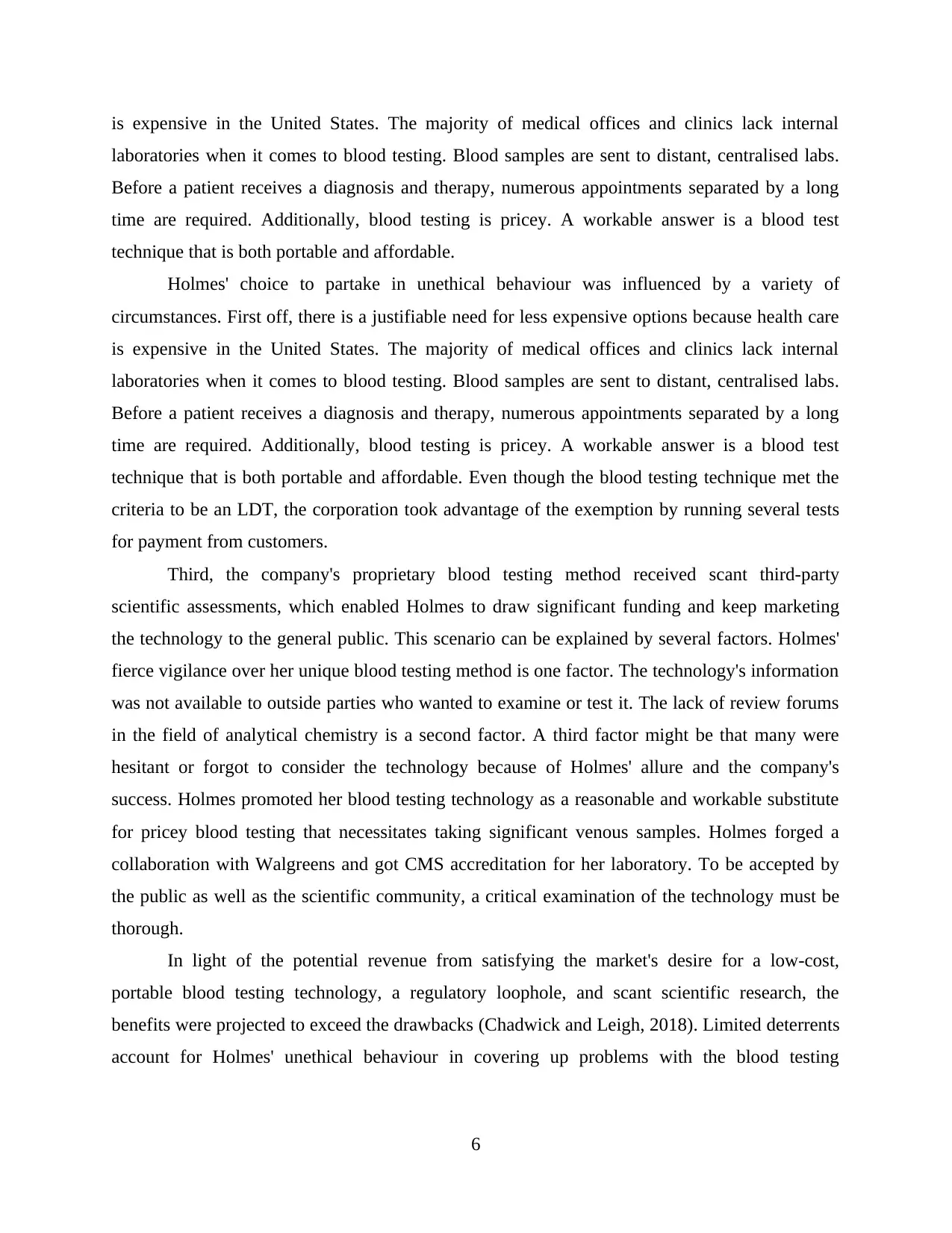
is expensive in the United States. The majority of medical offices and clinics lack internal
laboratories when it comes to blood testing. Blood samples are sent to distant, centralised labs.
Before a patient receives a diagnosis and therapy, numerous appointments separated by a long
time are required. Additionally, blood testing is pricey. A workable answer is a blood test
technique that is both portable and affordable.
Holmes' choice to partake in unethical behaviour was influenced by a variety of
circumstances. First off, there is a justifiable need for less expensive options because health care
is expensive in the United States. The majority of medical offices and clinics lack internal
laboratories when it comes to blood testing. Blood samples are sent to distant, centralised labs.
Before a patient receives a diagnosis and therapy, numerous appointments separated by a long
time are required. Additionally, blood testing is pricey. A workable answer is a blood test
technique that is both portable and affordable. Even though the blood testing technique met the
criteria to be an LDT, the corporation took advantage of the exemption by running several tests
for payment from customers.
Third, the company's proprietary blood testing method received scant third-party
scientific assessments, which enabled Holmes to draw significant funding and keep marketing
the technology to the general public. This scenario can be explained by several factors. Holmes'
fierce vigilance over her unique blood testing method is one factor. The technology's information
was not available to outside parties who wanted to examine or test it. The lack of review forums
in the field of analytical chemistry is a second factor. A third factor might be that many were
hesitant or forgot to consider the technology because of Holmes' allure and the company's
success. Holmes promoted her blood testing technology as a reasonable and workable substitute
for pricey blood testing that necessitates taking significant venous samples. Holmes forged a
collaboration with Walgreens and got CMS accreditation for her laboratory. To be accepted by
the public as well as the scientific community, a critical examination of the technology must be
thorough.
In light of the potential revenue from satisfying the market's desire for a low-cost,
portable blood testing technology, a regulatory loophole, and scant scientific research, the
benefits were projected to exceed the drawbacks (Chadwick and Leigh, 2018). Limited deterrents
account for Holmes' unethical behaviour in covering up problems with the blood testing
6
laboratories when it comes to blood testing. Blood samples are sent to distant, centralised labs.
Before a patient receives a diagnosis and therapy, numerous appointments separated by a long
time are required. Additionally, blood testing is pricey. A workable answer is a blood test
technique that is both portable and affordable.
Holmes' choice to partake in unethical behaviour was influenced by a variety of
circumstances. First off, there is a justifiable need for less expensive options because health care
is expensive in the United States. The majority of medical offices and clinics lack internal
laboratories when it comes to blood testing. Blood samples are sent to distant, centralised labs.
Before a patient receives a diagnosis and therapy, numerous appointments separated by a long
time are required. Additionally, blood testing is pricey. A workable answer is a blood test
technique that is both portable and affordable. Even though the blood testing technique met the
criteria to be an LDT, the corporation took advantage of the exemption by running several tests
for payment from customers.
Third, the company's proprietary blood testing method received scant third-party
scientific assessments, which enabled Holmes to draw significant funding and keep marketing
the technology to the general public. This scenario can be explained by several factors. Holmes'
fierce vigilance over her unique blood testing method is one factor. The technology's information
was not available to outside parties who wanted to examine or test it. The lack of review forums
in the field of analytical chemistry is a second factor. A third factor might be that many were
hesitant or forgot to consider the technology because of Holmes' allure and the company's
success. Holmes promoted her blood testing technology as a reasonable and workable substitute
for pricey blood testing that necessitates taking significant venous samples. Holmes forged a
collaboration with Walgreens and got CMS accreditation for her laboratory. To be accepted by
the public as well as the scientific community, a critical examination of the technology must be
thorough.
In light of the potential revenue from satisfying the market's desire for a low-cost,
portable blood testing technology, a regulatory loophole, and scant scientific research, the
benefits were projected to exceed the drawbacks (Chadwick and Leigh, 2018). Limited deterrents
account for Holmes' unethical behaviour in covering up problems with the blood testing
6
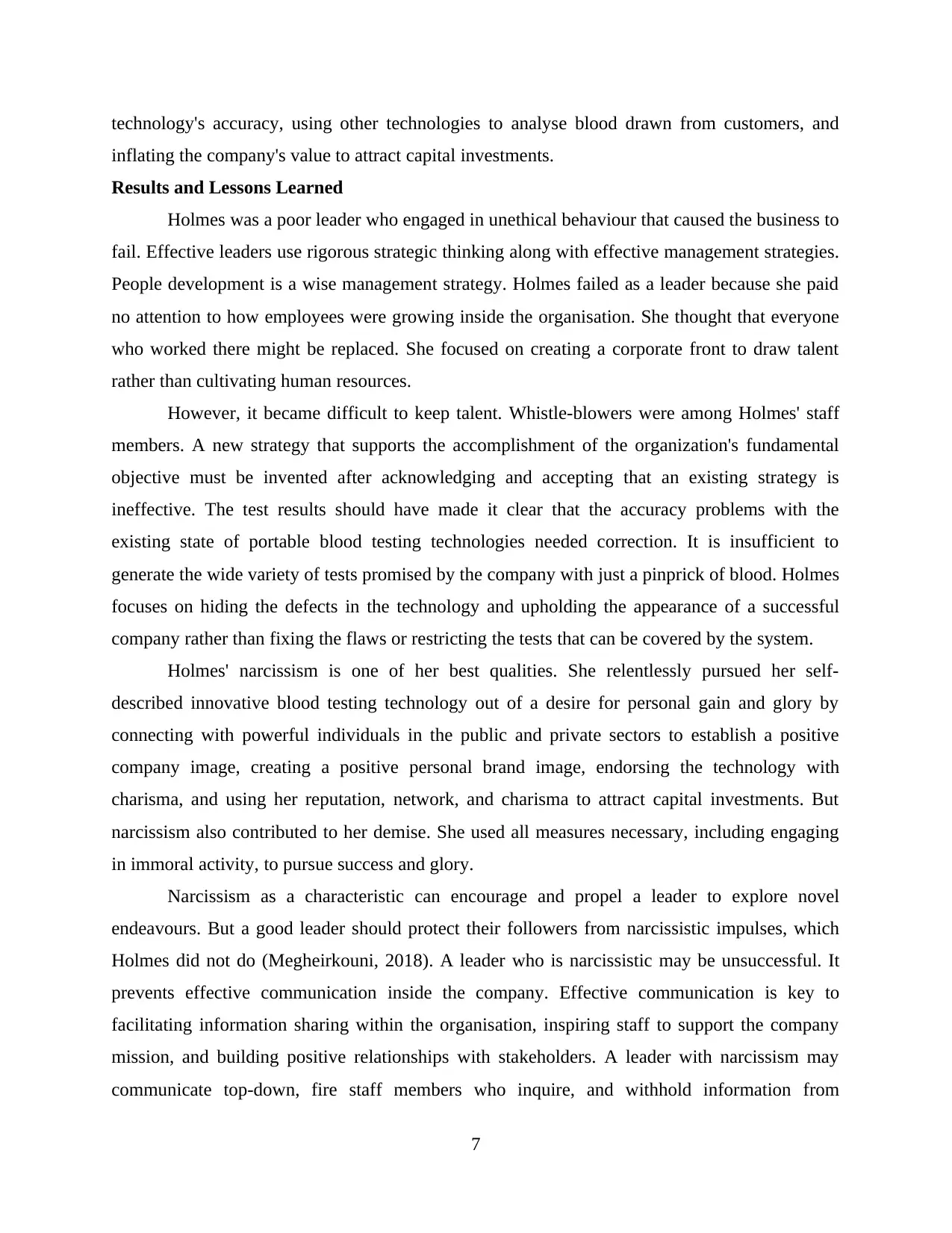
technology's accuracy, using other technologies to analyse blood drawn from customers, and
inflating the company's value to attract capital investments.
Results and Lessons Learned
Holmes was a poor leader who engaged in unethical behaviour that caused the business to
fail. Effective leaders use rigorous strategic thinking along with effective management strategies.
People development is a wise management strategy. Holmes failed as a leader because she paid
no attention to how employees were growing inside the organisation. She thought that everyone
who worked there might be replaced. She focused on creating a corporate front to draw talent
rather than cultivating human resources.
However, it became difficult to keep talent. Whistle-blowers were among Holmes' staff
members. A new strategy that supports the accomplishment of the organization's fundamental
objective must be invented after acknowledging and accepting that an existing strategy is
ineffective. The test results should have made it clear that the accuracy problems with the
existing state of portable blood testing technologies needed correction. It is insufficient to
generate the wide variety of tests promised by the company with just a pinprick of blood. Holmes
focuses on hiding the defects in the technology and upholding the appearance of a successful
company rather than fixing the flaws or restricting the tests that can be covered by the system.
Holmes' narcissism is one of her best qualities. She relentlessly pursued her self-
described innovative blood testing technology out of a desire for personal gain and glory by
connecting with powerful individuals in the public and private sectors to establish a positive
company image, creating a positive personal brand image, endorsing the technology with
charisma, and using her reputation, network, and charisma to attract capital investments. But
narcissism also contributed to her demise. She used all measures necessary, including engaging
in immoral activity, to pursue success and glory.
Narcissism as a characteristic can encourage and propel a leader to explore novel
endeavours. But a good leader should protect their followers from narcissistic impulses, which
Holmes did not do (Megheirkouni, 2018). A leader who is narcissistic may be unsuccessful. It
prevents effective communication inside the company. Effective communication is key to
facilitating information sharing within the organisation, inspiring staff to support the company
mission, and building positive relationships with stakeholders. A leader with narcissism may
communicate top-down, fire staff members who inquire, and withhold information from
7
inflating the company's value to attract capital investments.
Results and Lessons Learned
Holmes was a poor leader who engaged in unethical behaviour that caused the business to
fail. Effective leaders use rigorous strategic thinking along with effective management strategies.
People development is a wise management strategy. Holmes failed as a leader because she paid
no attention to how employees were growing inside the organisation. She thought that everyone
who worked there might be replaced. She focused on creating a corporate front to draw talent
rather than cultivating human resources.
However, it became difficult to keep talent. Whistle-blowers were among Holmes' staff
members. A new strategy that supports the accomplishment of the organization's fundamental
objective must be invented after acknowledging and accepting that an existing strategy is
ineffective. The test results should have made it clear that the accuracy problems with the
existing state of portable blood testing technologies needed correction. It is insufficient to
generate the wide variety of tests promised by the company with just a pinprick of blood. Holmes
focuses on hiding the defects in the technology and upholding the appearance of a successful
company rather than fixing the flaws or restricting the tests that can be covered by the system.
Holmes' narcissism is one of her best qualities. She relentlessly pursued her self-
described innovative blood testing technology out of a desire for personal gain and glory by
connecting with powerful individuals in the public and private sectors to establish a positive
company image, creating a positive personal brand image, endorsing the technology with
charisma, and using her reputation, network, and charisma to attract capital investments. But
narcissism also contributed to her demise. She used all measures necessary, including engaging
in immoral activity, to pursue success and glory.
Narcissism as a characteristic can encourage and propel a leader to explore novel
endeavours. But a good leader should protect their followers from narcissistic impulses, which
Holmes did not do (Megheirkouni, 2018). A leader who is narcissistic may be unsuccessful. It
prevents effective communication inside the company. Effective communication is key to
facilitating information sharing within the organisation, inspiring staff to support the company
mission, and building positive relationships with stakeholders. A leader with narcissism may
communicate top-down, fire staff members who inquire, and withhold information from
7
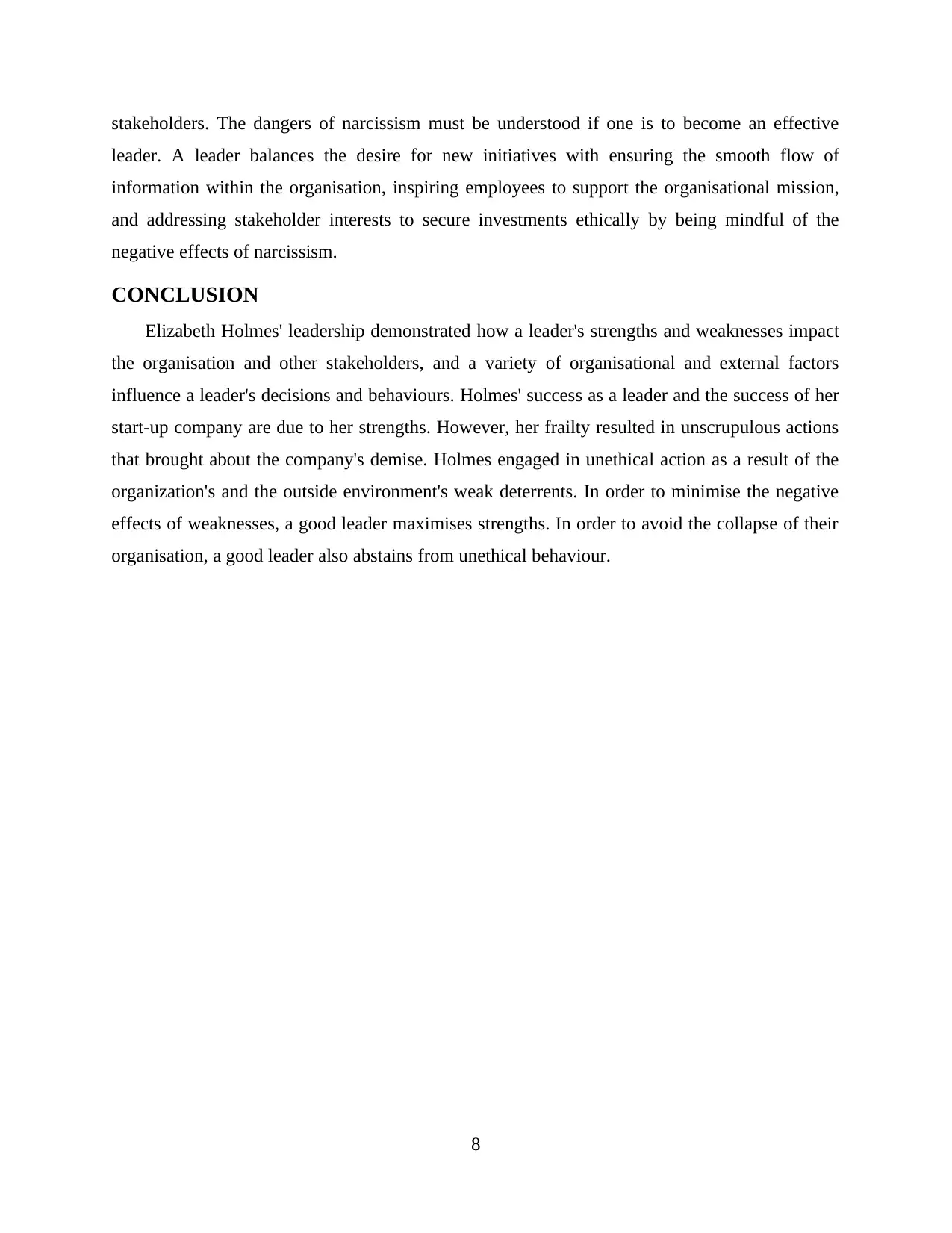
stakeholders. The dangers of narcissism must be understood if one is to become an effective
leader. A leader balances the desire for new initiatives with ensuring the smooth flow of
information within the organisation, inspiring employees to support the organisational mission,
and addressing stakeholder interests to secure investments ethically by being mindful of the
negative effects of narcissism.
CONCLUSION
Elizabeth Holmes' leadership demonstrated how a leader's strengths and weaknesses impact
the organisation and other stakeholders, and a variety of organisational and external factors
influence a leader's decisions and behaviours. Holmes' success as a leader and the success of her
start-up company are due to her strengths. However, her frailty resulted in unscrupulous actions
that brought about the company's demise. Holmes engaged in unethical action as a result of the
organization's and the outside environment's weak deterrents. In order to minimise the negative
effects of weaknesses, a good leader maximises strengths. In order to avoid the collapse of their
organisation, a good leader also abstains from unethical behaviour.
8
leader. A leader balances the desire for new initiatives with ensuring the smooth flow of
information within the organisation, inspiring employees to support the organisational mission,
and addressing stakeholder interests to secure investments ethically by being mindful of the
negative effects of narcissism.
CONCLUSION
Elizabeth Holmes' leadership demonstrated how a leader's strengths and weaknesses impact
the organisation and other stakeholders, and a variety of organisational and external factors
influence a leader's decisions and behaviours. Holmes' success as a leader and the success of her
start-up company are due to her strengths. However, her frailty resulted in unscrupulous actions
that brought about the company's demise. Holmes engaged in unethical action as a result of the
organization's and the outside environment's weak deterrents. In order to minimise the negative
effects of weaknesses, a good leader maximises strengths. In order to avoid the collapse of their
organisation, a good leader also abstains from unethical behaviour.
8
Secure Best Marks with AI Grader
Need help grading? Try our AI Grader for instant feedback on your assignments.
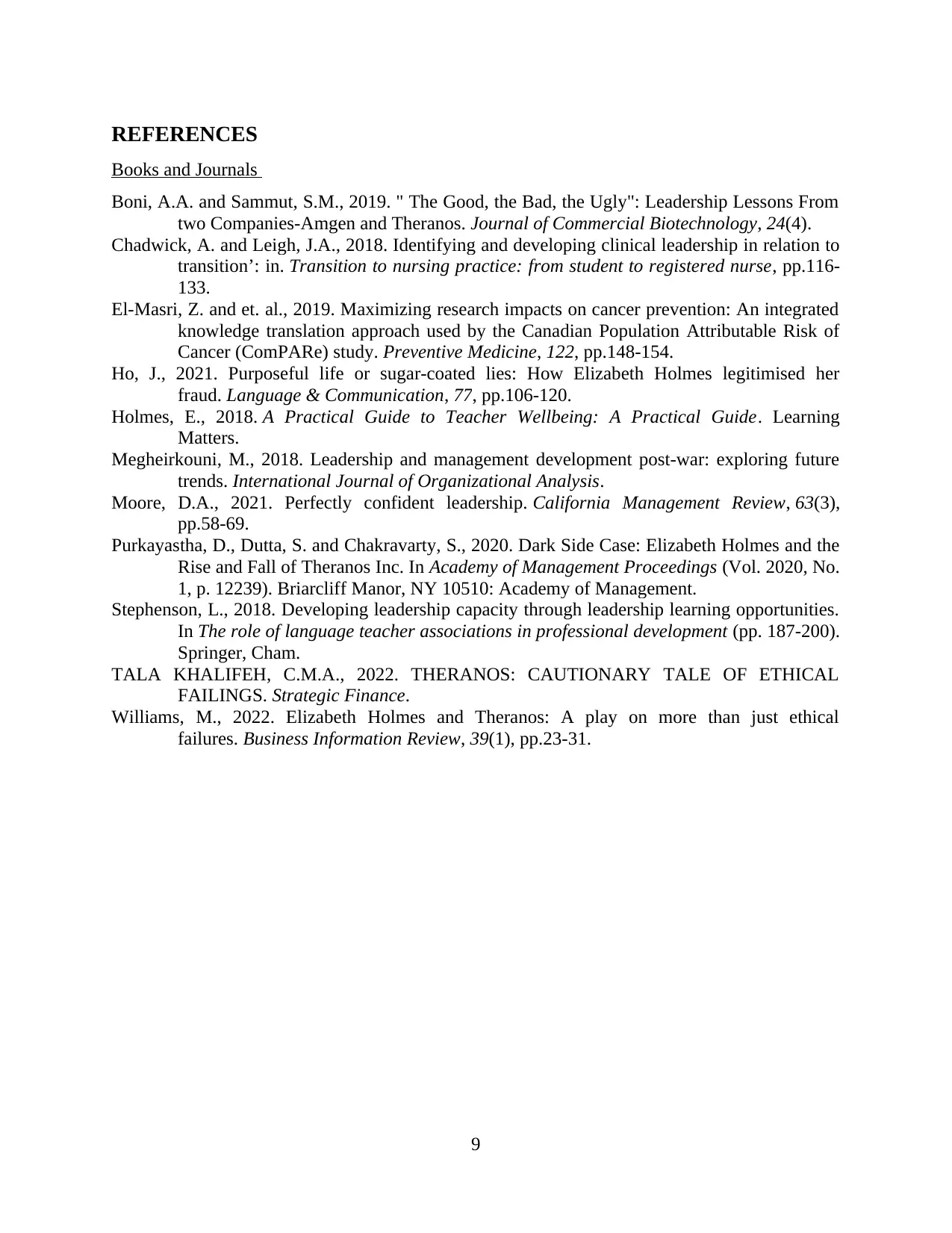
REFERENCES
Books and Journals
Boni, A.A. and Sammut, S.M., 2019. " The Good, the Bad, the Ugly": Leadership Lessons From
two Companies-Amgen and Theranos. Journal of Commercial Biotechnology, 24(4).
Chadwick, A. and Leigh, J.A., 2018. Identifying and developing clinical leadership in relation to
transition’: in. Transition to nursing practice: from student to registered nurse, pp.116-
133.
El-Masri, Z. and et. al., 2019. Maximizing research impacts on cancer prevention: An integrated
knowledge translation approach used by the Canadian Population Attributable Risk of
Cancer (ComPARe) study. Preventive Medicine, 122, pp.148-154.
Ho, J., 2021. Purposeful life or sugar-coated lies: How Elizabeth Holmes legitimised her
fraud. Language & Communication, 77, pp.106-120.
Holmes, E., 2018. A Practical Guide to Teacher Wellbeing: A Practical Guide. Learning
Matters.
Megheirkouni, M., 2018. Leadership and management development post-war: exploring future
trends. International Journal of Organizational Analysis.
Moore, D.A., 2021. Perfectly confident leadership. California Management Review, 63(3),
pp.58-69.
Purkayastha, D., Dutta, S. and Chakravarty, S., 2020. Dark Side Case: Elizabeth Holmes and the
Rise and Fall of Theranos Inc. In Academy of Management Proceedings (Vol. 2020, No.
1, p. 12239). Briarcliff Manor, NY 10510: Academy of Management.
Stephenson, L., 2018. Developing leadership capacity through leadership learning opportunities.
In The role of language teacher associations in professional development (pp. 187-200).
Springer, Cham.
TALA KHALIFEH, C.M.A., 2022. THERANOS: CAUTIONARY TALE OF ETHICAL
FAILINGS. Strategic Finance.
Williams, M., 2022. Elizabeth Holmes and Theranos: A play on more than just ethical
failures. Business Information Review, 39(1), pp.23-31.
9
Books and Journals
Boni, A.A. and Sammut, S.M., 2019. " The Good, the Bad, the Ugly": Leadership Lessons From
two Companies-Amgen and Theranos. Journal of Commercial Biotechnology, 24(4).
Chadwick, A. and Leigh, J.A., 2018. Identifying and developing clinical leadership in relation to
transition’: in. Transition to nursing practice: from student to registered nurse, pp.116-
133.
El-Masri, Z. and et. al., 2019. Maximizing research impacts on cancer prevention: An integrated
knowledge translation approach used by the Canadian Population Attributable Risk of
Cancer (ComPARe) study. Preventive Medicine, 122, pp.148-154.
Ho, J., 2021. Purposeful life or sugar-coated lies: How Elizabeth Holmes legitimised her
fraud. Language & Communication, 77, pp.106-120.
Holmes, E., 2018. A Practical Guide to Teacher Wellbeing: A Practical Guide. Learning
Matters.
Megheirkouni, M., 2018. Leadership and management development post-war: exploring future
trends. International Journal of Organizational Analysis.
Moore, D.A., 2021. Perfectly confident leadership. California Management Review, 63(3),
pp.58-69.
Purkayastha, D., Dutta, S. and Chakravarty, S., 2020. Dark Side Case: Elizabeth Holmes and the
Rise and Fall of Theranos Inc. In Academy of Management Proceedings (Vol. 2020, No.
1, p. 12239). Briarcliff Manor, NY 10510: Academy of Management.
Stephenson, L., 2018. Developing leadership capacity through leadership learning opportunities.
In The role of language teacher associations in professional development (pp. 187-200).
Springer, Cham.
TALA KHALIFEH, C.M.A., 2022. THERANOS: CAUTIONARY TALE OF ETHICAL
FAILINGS. Strategic Finance.
Williams, M., 2022. Elizabeth Holmes and Theranos: A play on more than just ethical
failures. Business Information Review, 39(1), pp.23-31.
9
1 out of 11
Your All-in-One AI-Powered Toolkit for Academic Success.
+13062052269
info@desklib.com
Available 24*7 on WhatsApp / Email
![[object Object]](/_next/static/media/star-bottom.7253800d.svg)
Unlock your academic potential
© 2024 | Zucol Services PVT LTD | All rights reserved.